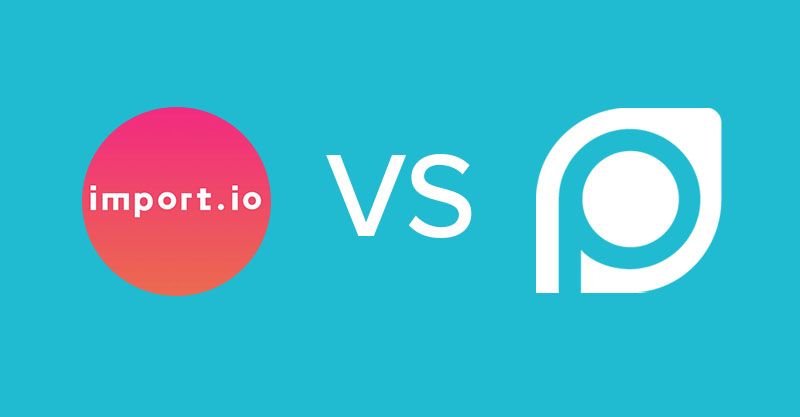Import.io and ParseHub are both very popular web scraping tools.
While at first sight, they might seem quite similar, there are a few key differences between the two.
Let’s break it all down in this head-to-head comparison between these two web scrapers.
Import.io Introduction
Importi.io was founded in 2012, with the release of their first web scraper. Import.io is an entirely web-based scraper. This means that instead of downloading software to your computer, you access the tool through your web browser.
While they still support their web scraping tool, the company has shifted its focus towards managed data services that are custom-built for their clients.
ParseHub Introduction
ParseHub is an incredibly versatile web scraper that comes as a free desktop app. The actual scraping occurs on the cloud as well, which clears up your computer’s resources while completing your jobs.
While ParseHub does offer custom solutions for enterprise clients, its main focus is still its web scraping tool and providing support for its users.
What can you do with ParseHub?

The biggest difference between ParseHub and its web scraping alternatives is that ParseHub can get data from interactive websites.
You can instruct ParseHub to scrape data from very complex and dynamic sites, because it can:
- select choices from dropdown menus, radio buttons and tabs
- search with a search bar
- get data from infinitely scrolling pages
And more! These are all things that import.io cannot handle.
Here is a full list of ParseHub's scraping features:
|
Automatic IP Rotation |
Get data from tables and maps |
Conditionals and expressions |
|
Content that loads with AJAX and JavaScript |
Search through forms and inputs |
XPATH, Regular Expressions and CSS Selectors |
|
Extract text, HTML and attributes |
Get data from drop-downs, tabs and pop-ups |
REST API with web hooks |
|
Download files and images |
Pagination and navigation |
Dropbox and Google Sheets integration |
|
Scrape content from infinitely scrolling pages |
Scheduled Runs |
Regular expression selection |
ParseHub’s versatility is fully unlocked once you learn how to use its commands. Think of them as the different actions you can ask the scraper to do.
Luckily, the application is intuitive and there are plenty of tutorials to help you in the help center if you get stuck!
What can you do with Import.io?
Import.io will let you extract data by learning a minimal number of commands. It can only be used on simple, or static, web pages, but some projects may take just seconds of work to build in Import.io, whereas it may take you more time to build content with ParseHub.
Not only do the web pages need to be simple, but the website URLs need to be as well.
When a new project is started, import.io tries to guess what you want from the page. They used to call this feature Magic Extraction. For very simple websites, this usually provides a good starting place for the project and could cut down the time to build an extractor down to just a few seconds.
What can you do with both?
Both web scraping tools will let you download extracted data as CSV's and as JSON. Both will let you import data directly into a Google Sheet and can be controlled as an API. You can schedule runs with Import.io and with ParseHub, too, depending on your payment plan.
When building your project, you can get real-time feedback from ParseHub's sample and test runs, or from Import.io's data view. Both web scrapers allow you to use regular expressions to scrape only the text that you want.
You create extractors to extract data with import.io, and templates to extract data with ParseHub. These are very similar: they are both sets of instructions that the software uses to select and extract items from a webpage.
However, an import.io user doesn't enter the commands directly. Instead, they train the extractor to select and extract what they want from a page. On the other hand, a ParseHub user enters commands directly into the template. When ParseHub executes the template, it follows the instructions exactly as entered. When import.io executes a template, it remembers what the user trained it to do, and executes the same way.
This is an example ParseHub project. You can see all of the different commands that the user entered, like Select, Hover, and Extract, in the left sidebar.
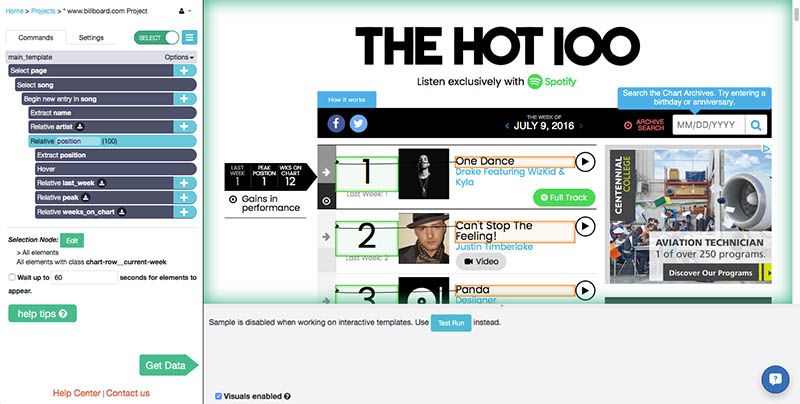
Training the import.io extractor takes place in their "website view", as seen below.
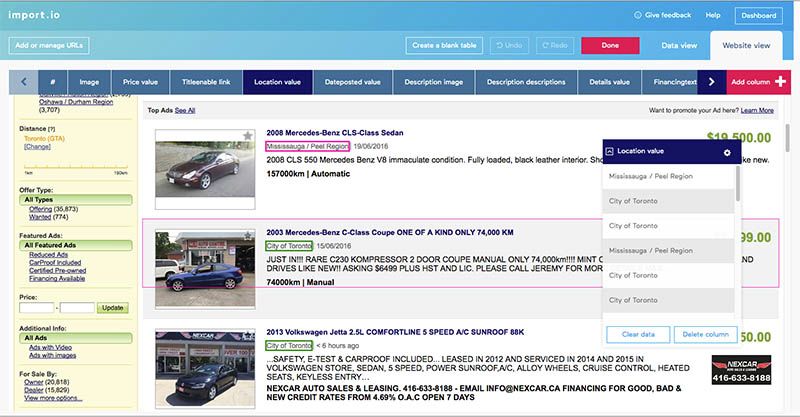
Scraping Commands
You can only train import.io to select and extract items on a web page. Meanwhile, ParseHub has a wider variety of commands that allow a user to navigate through web pages and deal with interactive elements.
List of ParseHub commands that can be combined to perform advanced scraping functions:
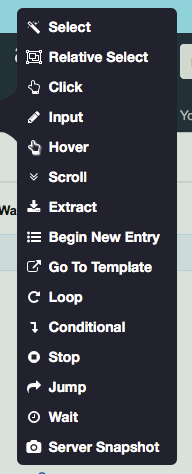
ParseHub Pricing vs Import.io Pricing
This is probably the first comparison between import.io and ParseHub that you want to see: which web scraping software gives you the best bang for your buck? The answer is not quite clear cut, as ParseHub's plans and Import.io's plans have different limitations.
ParseHub's plans are limited by:
- the number of projects that can be saved
- the number of web pages you can scrape data from per run
- the speed at which you can collect data
Import.io limits the number of:
- queries per month
- the number of runs that you can store results for
It’s important to keep in mind that Import.io has updated their prices to accommodate their focus towards custom-made solutions.
As a result, any paid plans for their tools will be custom quoted to your needs and could vary drastically in pricing depending on what your needs are.
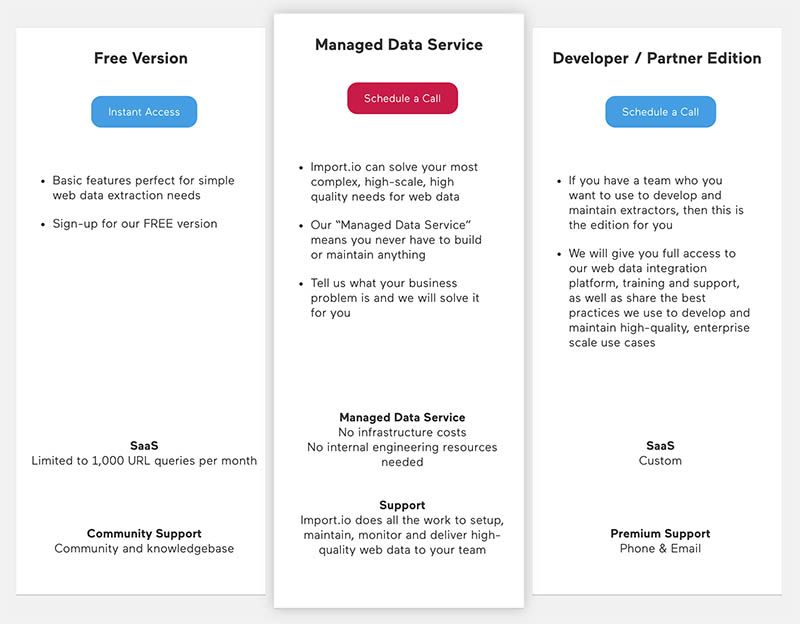
In contrast, ParseHub offers straight-forward base prices for all paid updates. You are free to upgrade and downgrade your plan any time
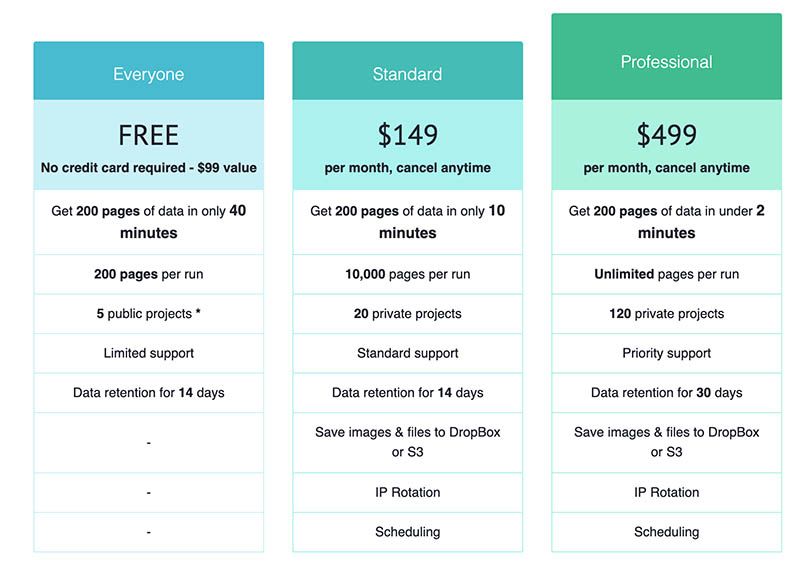
Most people build one ParseHub project per website, spanning over many separate web pages. Projects are not limited by the number of times they can be run.
On the other hand, each page extracted by import.io counts as one query, so the total number of queries you get in a month is the number of pages that can be extracted.
On-Demand Scrapes
If you don't want to learn how to use a tool and just want your data on demand, both ParseHub and Import.io offer a service that extracts data for you. Just contact sales of both companies and someone will scrape data from the website you want – delivering them in CSV/Excel or API format.
Web Scraping Example
We tested out both Import.io and ParseHub on Amazon to see how they compare. First, let's have a look at Import.io and then go to ParseHub.
Scraping Goal: get pricing details for every single watch sold by one of Amazon's "Top Brands".
Import.io project
First extractor
First, we find the list of watch brands in amazon.ca's Top Brands. We want to scrape information from each one of the watch brands listed here.
Import.io will be able to do this if you have a list of each one the URLs. You will create an extractor to scrape this page and get this list.
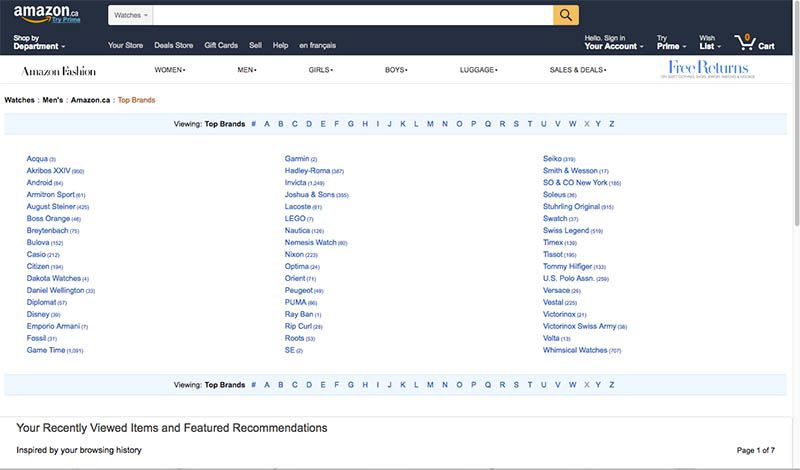
When you start a new extractor in Import.io, it first tries to guess what you are trying to extract on the page. For this particular web page, it took about 10 seconds to load a table with the data it thought I wanted.
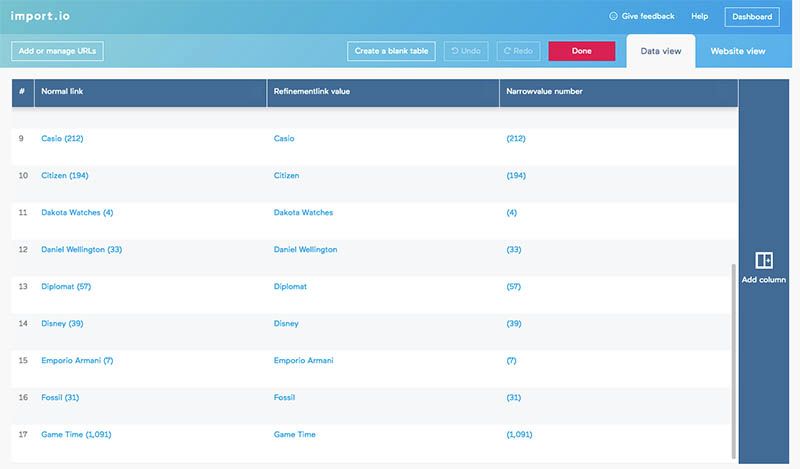
After looking over the software's first guess, you then turn to the website view tab to refine your training. In this case, import.io only selected the first column of brands, and I wanted all three columns, so I had to train the extractor to do that.
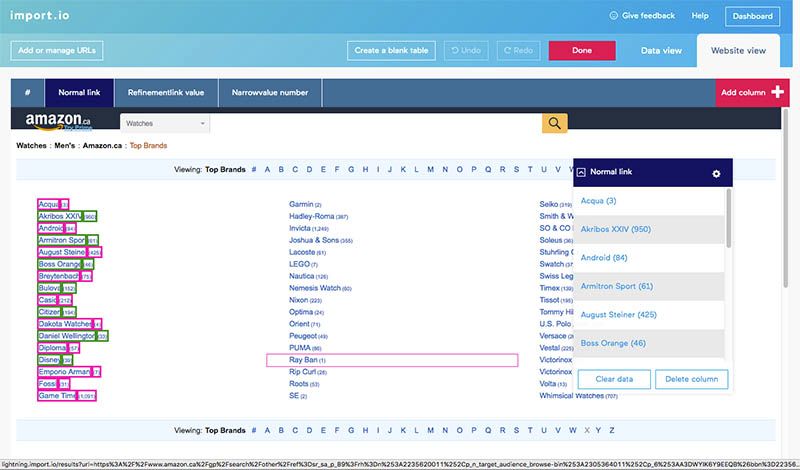
Unfortunately, when I clicked on the other brand names, the software didn't recognize that I wanted to select them all and so only selected one at a time. Instead of clicking on 34 more brands, I decided to delete the already extracted columns and start from scratch.
I clicked on three brands, the first, middle and last, and then import.io automatically selected all of the others.
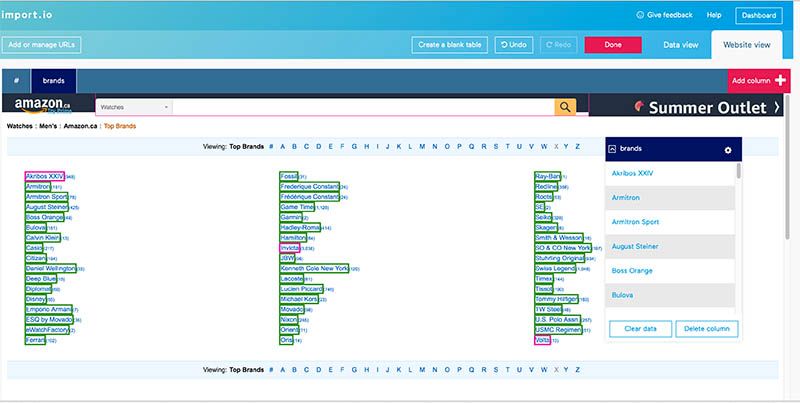
I was happy with the data view so I ran the extractor and downloaded the CSV file of the links. It didn't look exactly like the data I saw on the website: there are three columns instead of just one with the URLs like I wanted.

In old versions of Import.io, it was possible to "chain" extractors together so that the links extracted by one would automatically be sent to the other. However, it does not seem like it is possible to do this with the current version without any manual entering or without creating a script using the Import.io API.
Second extractor
I trained the next extractor on one of the links I got from the CSV given to me from the first extractor. I chose a brand that had lots of different watches so that there was more than one page of results. This time, Import.io's initial guess did select all the watches on the page and required less additional training than the first one.
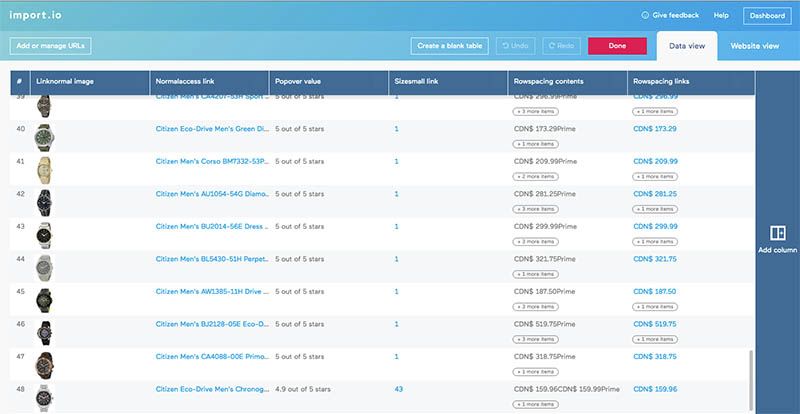
Back in website view, I trained the extractor to select and extract exactly what I wanted. Lastly, I used the regular expressions option to remove the unwanted "CDN$" prefix that was in front of all the prices.
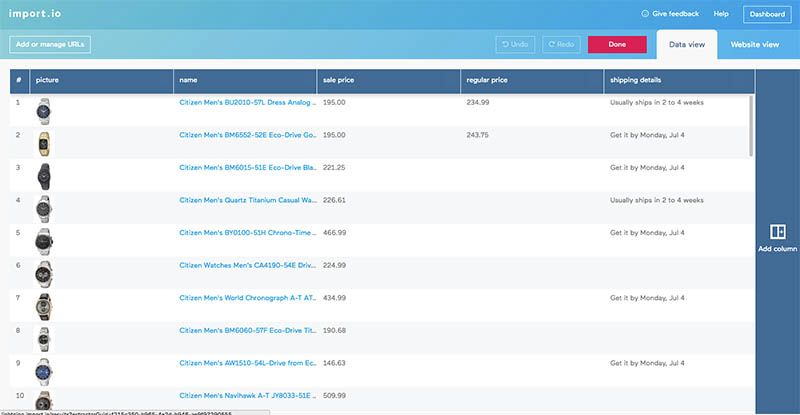
In total, I was able to complete the training for this extractor fairly quickly, in 4 or 5 minutes. I now had to input links to all of the different pages that I wanted to be included in my query. This was a problem that I didn't know how to resolve.
Import.io's URL generator only helps generate URLs if the pages follow an obvious pattern. On amazon.ca, they do not. The page URLs are all very long, and there seems to be very little correlation between the URL of page 1 and page 2 of the same brand. Additionally, I had to copy and paste the links column from the CSV into a word document and add a line break at the end of each URL manually in order to put the list into the second extractor - I wasn't able to find an easier way to do this.
Pros:
- Training both templates took a very short amount of time - most columns of data required 2 or 3 clicks so it took only minutes to select everything that was needed.
- Regular expressions were able to remove the unwanted prefixes before exporting the data
Cons:
- Import.io failed to travel to every page because there was no pattern to amazon.ca's URLs. Instead of every single watch, like I had wanted, I was only able to scrape the first page of each brand.
- There was no easy way to "chain" the extractors together, and that meant I had to manually enter line breaks after each URL that was scraped. I would have had to write a script to do this for me if there had been hundreds or thousands of URLs - which isn't practical for someone who is using the tool because they don't know how to code!
- Columns of unwanted and unexpected data were extracted.
ParseHub project
Main template
The ParseHub project started on the same page as the Import.io project. It took 2 clicks to select all of the bands on the page, and then ParseHub was told to click on each one of them and go to the next template, called brand.
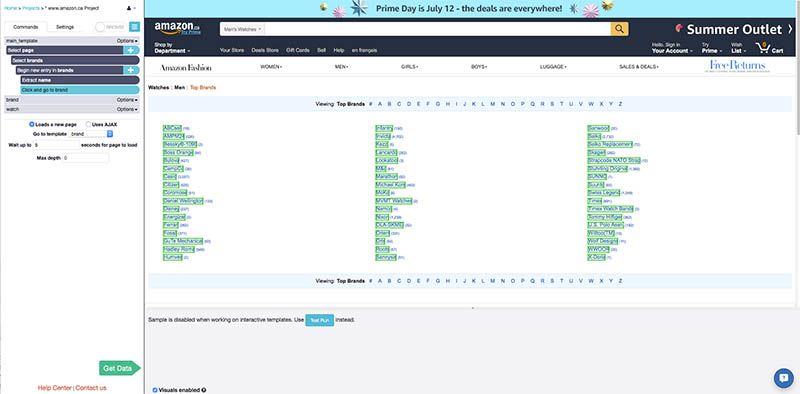
Brand template
To create this template, I travelled to the first page of one of the brands that had lots of watches, so that I could make ParseHub travel to multiple pages of results.
Clicking on the names of two of the watches caused all of them to be selected, and then I used the Relative Select tool to select and extract all of the other information that I wanted. Just like with the import.io project, I was able to use regular expressions to remove the unwanted prefix before the prices.
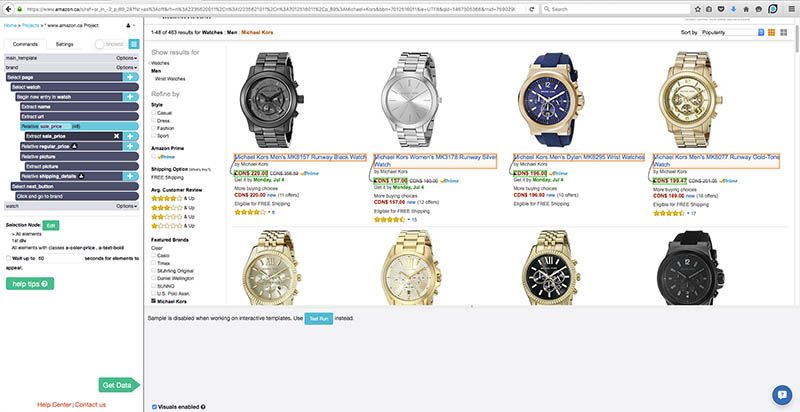
I added one last Select command to travel to the next page of results using the "Next" button. Once ParseHub clicks on it, it will execute the template again and extract all the data that I instructed it to.
The "Next" button on the final page of results does not lead to a new page, so I used XPath selection in order to select the button only when it is linked to a new page. That way, ParseHub will not start this template again after the final page, and will instead go to the next brand in the main_template list.
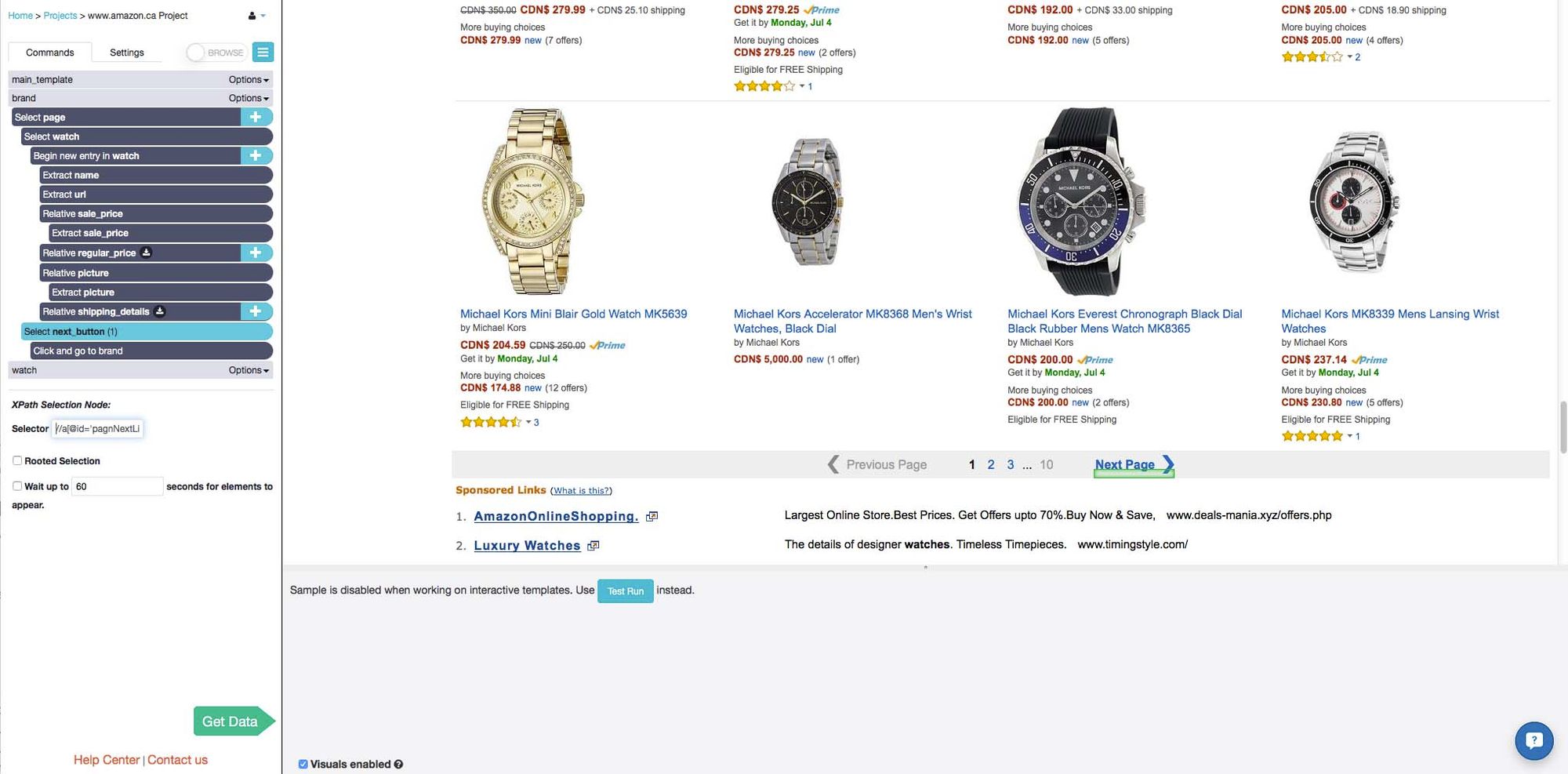
Pros:
- ParseHub handled the amazon.ca pagination very well. It was able to travel to each brand on the list, and also able to travel to every page within a brand.
- Regular expressions removed unwanted prefixes.
- Data columns were exactly what was needed, no more and no less.
- ParseHub's navigation tools make it easy to add to this project and get even more information about the watches: you can click on each watch, or hover over them, to reveal more details.
Cons:
- XPath selection is an advanced technique that would be difficult for a beginner user to use.
Final thoughts
It is very quick and easy to put together an Import.io extractor. On many of the websites that I have tested, the "magic extractor"'s initial guess works almost exactly how you want it to, meaning you can start running your extractor just a minute or two after creating it.
But it doesn't matter how quickly the web extractor is trained, it is frankly severely limited by the way it navigates through pages and interacts with dynamic objects.
I wasn't able to complete the project I used as an example here because of this limitation, I chose a simple and realistic use case.
So which web scraper is the best for your project?
The truth is that it depends. Mostly, it depends on the needs of your scraping project.
We’d recommend you try the free trial from both tools and take them out for a test drive before settling on an option.
[This post was originally written on July 12, 2016 and updated on August 9, 2019]
